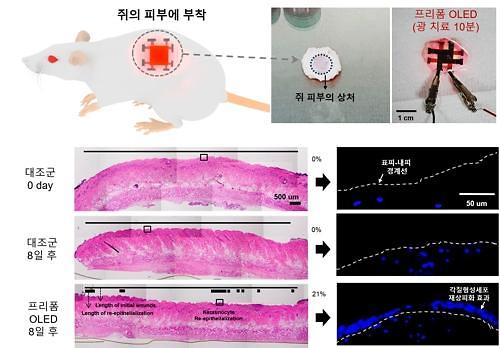
[Courtesy of the National Research Foundation]
The National Research Foundation (NRF), a state research foundation, said in a statement on Wednesday that a joint team of researchers from the Korea Advanced Institute of Science & Technology (KAIST), a prestigious state science school, and Seoul National University Bundang Hospital has developed a "freeform" OLED material.
"It can be used as a mask pack for skincare and a patch for wounds as well as a wearable device for optical purposes attached to clothes or hats," KAIST professor Choi Kyung-cheol was quoted as saying.
NRF said the 10-micrometer-thin sheet of OLED is composed of sandwich-like layers of a 0.4-micrometer-thin OLED layer and two layers of 4.8-micrometer-thin films. The film was produced using plastics and adhesives to create barriers to protect OLEDs. The research institute said the ultra-thin OLED sheet can adhere to any surface including apparels and paper.
The freeform OLED maintained its operational state after being submerged. The research team also found that the freeform OLED worked normally despite the repeated folding of one thousand times.
Researchers tested the OLED sheet on the skin of a rat. It was adhered to a region where keratinocyte, the outermost layer of skin, was removed to receive light for 10 minutes every day. After eight days, the rat's keratinocyte regenerated by 21 percent. Similar test results were found in human tests. Those who received light therapy had 30 percent thicker layer of keratinocyte.
The NRF's OLED sheet research was published in the December issue of "Light Science & Applications", an international scientific journal.




![[CES2024] LG Electronics to showcase wireless transparent OLED TV for first time at CES](https://image.ajunews.com/content/image/2024/01/08/20240108155434102725.jpg)